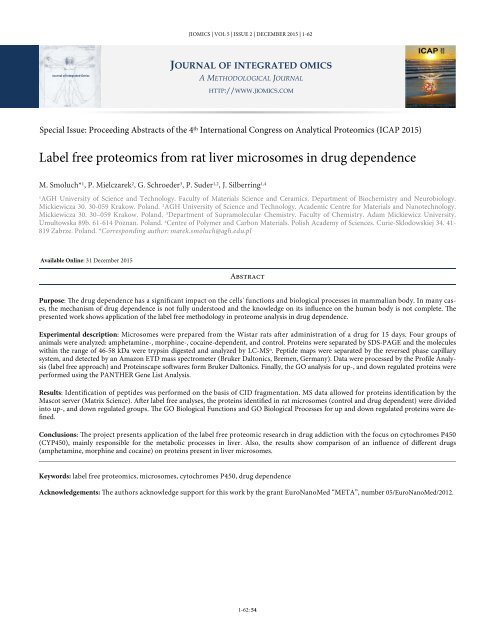JIOMICS
JIOMICS Internacional
JIOMICS Internacional
You also want an ePaper? Increase the reach of your titles
YUMPU automatically turns print PDFs into web optimized ePapers that Google loves.
<strong>JIOMICS</strong> | VOL 5 | ISSUE 2 | DECEMBER 2015 | 1-62<br />
JOURNAL OF INTEGRATED OMICS<br />
Journal of Integrated Omics<br />
A METHODOLOGICAL JOURNAL<br />
HTTP://WWW.<strong>JIOMICS</strong>.COM<br />
Special Issue: Proceeding Abstracts of the 4 th International Congress on Analytical Proteomics (ICAP 2015)<br />
Label free proteomics from rat liver microsomes in drug dependence<br />
M. Smoluch* 1 , P. Mielczarek 2 , G. Schroeder 3 , P. Suder 1,2 , J. Silberring 1,4<br />
1<br />
AGH University of Science and Technology. Faculty of Materials Science and Ceramics. Department of Biochemistry and Neurobiology.<br />
Mickiewicza 30. 30-059 Krakow. Poland. 2 AGH University of Science and Technology. Academic Centre for Materials and Nanotechnology.<br />
Mickiewicza 30. 30–059 Krakow. Poland. 3 Department of Supramolecular Chemistry. Faculty of Chemistry. Adam Mickiewicz University.<br />
Umultowska 89b. 61-614 Poznan. Poland. 4 Centre of Polymer and Carbon Materials. Polish Academy of Sciences. Curie-Sklodowskiej 34. 41-<br />
819 Zabrze. Poland. *Corresponding author: marek.smoluch@agh.edu.pl<br />
Available Online: 31 December 2015<br />
Abstract<br />
Purpose: The drug dependence has a significant impact on the cells' functions and biological processes in mammalian body. In many cases,<br />
the mechanism of drug dependence is not fully understood and the knowledge on its influence on the human body is not complete. The<br />
presented work shows application of the label free methodology in proteome analysis in drug dependence.<br />
Experimental description: Microsomes were prepared from the Wistar rats after administration of a drug for 15 days. Four groups of<br />
animals were analyzed: amphetamine-, morphine-, cocaine-dependent, and control. Proteins were separated by SDS-PAGE and the molecules<br />
within the range of 46-58 kDa were trypsin digested and analyzed by LC-MS n . Peptide maps were separated by the reversed phase capillary<br />
system, and detected by an Amazon ETD mass spectrometer (Bruker Daltonics, Bremen, Germany). Data were processed by the Profile Analysis<br />
(label free approach) and Proteinscape softwares form Bruker Daltonics. Finally, the GO analysis for up-, and down regulated proteins were<br />
performed using the PANTHER Gene List Analysis.<br />
Results: Identification of peptides was performed on the basis of CID fragmentation. MS data allowed for proteins identification by the<br />
Mascot server (Matrix Science). After label free analyses, the proteins identified in rat microsomes (control and drug dependent) were divided<br />
into up-, and down regulated groups. The GO Biological Functions and GO Biological Processes for up and down regulated proteins were defined.<br />
Conclusions: The project presents application of the label free proteomic research in drug addiction with the focus on cytochromes P450<br />
(CYP450), mainly responsible for the metabolic processes in liver. Also, the results show comparison of an influence of different drugs<br />
(amphetamine, morphine and cocaine) on proteins present in liver microsomes.<br />
Keywords: label free proteomics, microsomes, cytochromes P450, drug dependence<br />
Acknowledgements: The authors acknowledge support for this work by the grant EuroNanoMed “META”, number 05/EuroNanoMed/2012.<br />
1-62: 54


